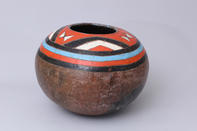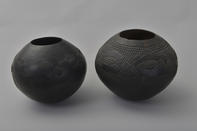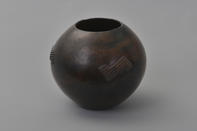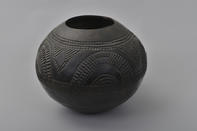Venda pottery goes back to the 14th and 15th centuries. Until recently pots like these were normally decorated with geometric patterns, including concentric circles.

In most cases, motifs were incised onto the surface before being filled in with graphite and red oxide. Because potters now rely increasingly on enamel paints, there is often a stark contrast between the decorated shoulder and the rugged base of these heavy pots.

Some potters inscribe figurative motifs onto their pots. Commonly chosen forms include flowers and fish. Efforts to ascribe meanings to decorative elements like these are seldom credible.
Flowers have been linked to the idea of peace, beauty, goodwill and regeneration, while the sun has been said to suggest something which ‘shines’, or is outstanding, and so on. Regardless of possible symbolic intentions, decorations on the shoulders of beer pots are functional, making it easier for the drinker to grip the pot when it is slippery.

In the Nongoma-Ondini area where the current Zulu king, Goodwill Zwelethini, has several royal homesteads, potters have been decorating their vessels with amasumpa motifs since at least the late 19th century.
These decorations are added in a number of different ways, most often as strips or panels of clay. Others are ‘pinched’ or rounded and flattened before being applied singly. A further variation involves pressing the clay out from the inside of the pot while the clay is still pliable. The latter techniques tend to yield comparatively shallow amasumpa patterns.

Potters working in contemporary KwaZulu-Natal often decorate pots with chevrons, V’s, W’s, short zigs-zags and derivatives of zigzags. These patterns are either applied, or impressed or incised depending on whether clay is added to the surface or removed from it. Some clay motifs are cut into the pot, while others are gouged out of them.
Potters often rely on the use of combs and other artefacts, including penknives, to achieve particular decorative effects. Skilled producers like Phiwayinkosi MaMthethwa Ngobese of Mayakazi, Hlabisa, who was born in Vryheid in the early 1930s and who used to sell her vessels at the Mona Market near Nongoma, were pioneers in the use of new and sometimes unusual tools to decorate their pots. Another acclaimed potter, Ntombi Nala, who was born in 1953, adds beadwork decorations to her drinking vessels.
By Professor Sandra Klopper